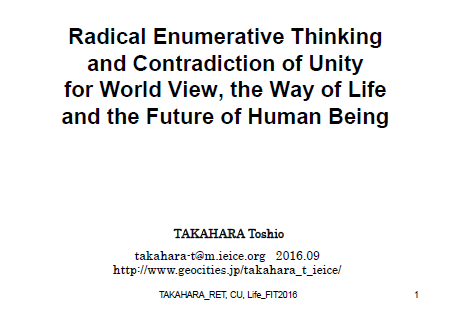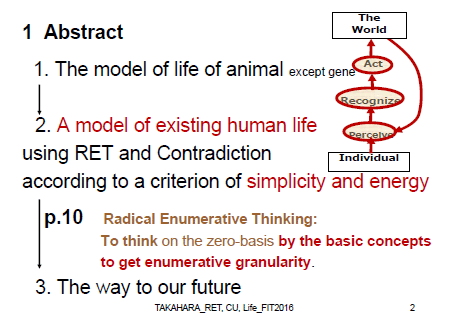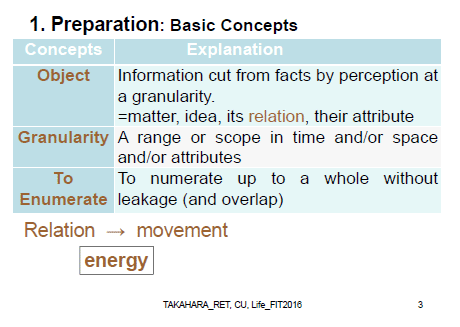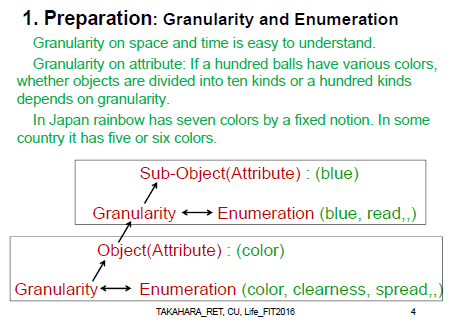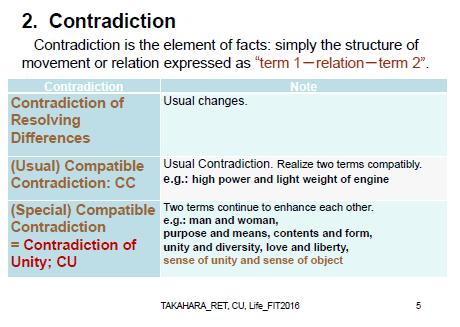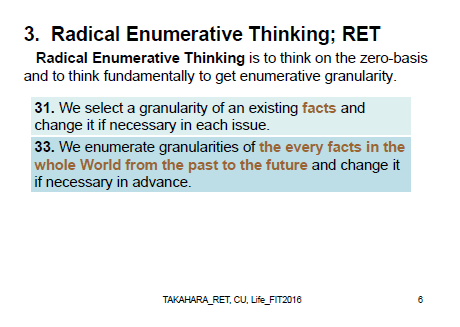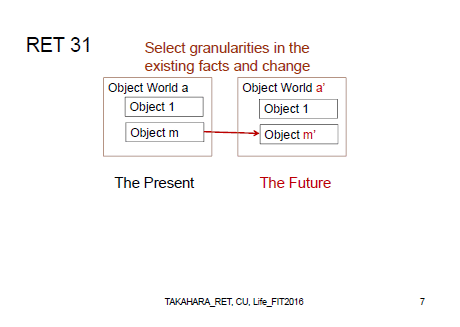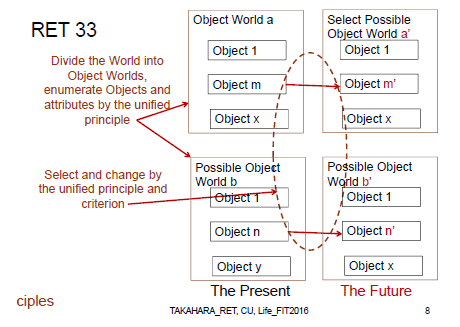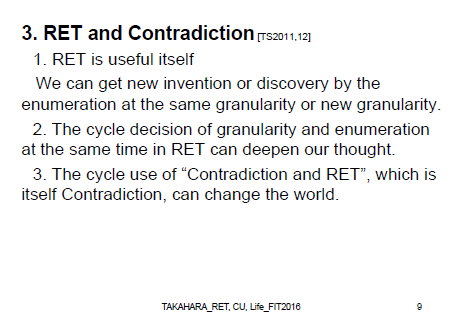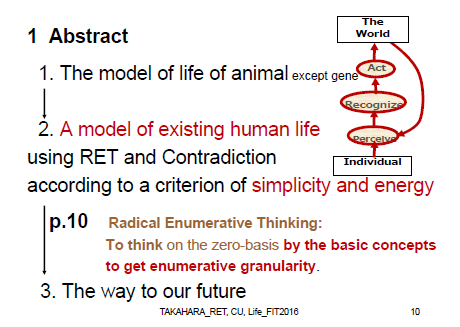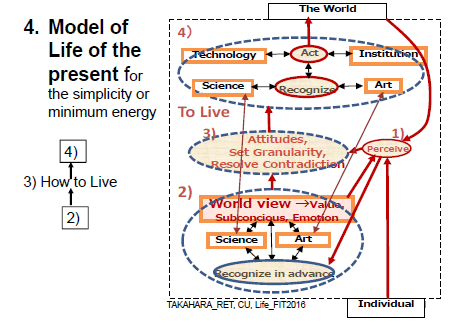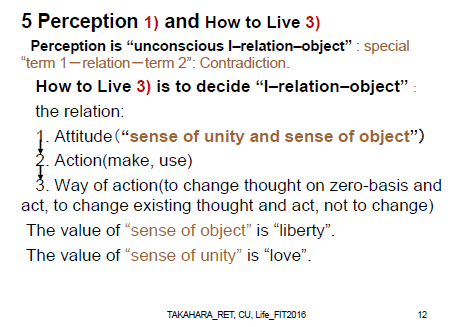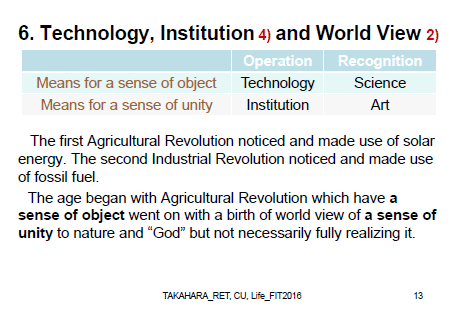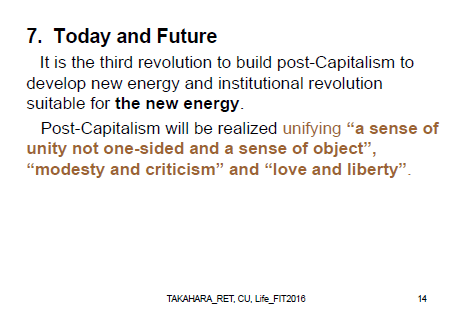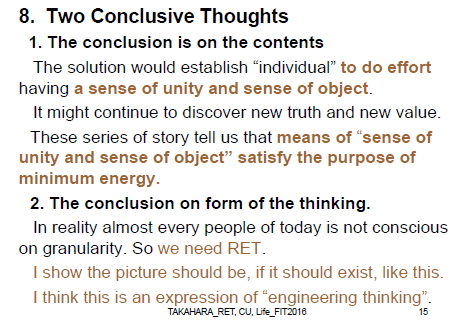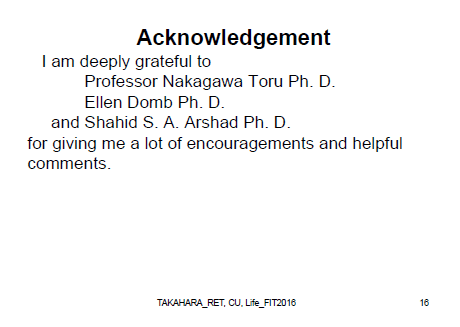Editor's Note (Toru Nakagawa, Oct. 6, 2016)
Radical Enumerative Thinking and Contradiction of Unity
for World View, the Way of Life and the Future of Human Being
Toshio TAKAHARA
FIT 2016 (Forum on Information Technology in Japan)
September 7 - 9, 2016, Toyama University, Toyama Prefecture
.
1.Preface and Abstract [FIT2013] [FIT 2015]
.
1. Human being is continuing their progress.
But we are confronted with complicated issues in front of us that economic or political institution or personal issue causes. We need to find a new way of life.
We have two ways to realize them. One is to change the existing thought on objects and act. The other is to do so on the zero-basis. It is the time to take the zero-basis thinking as the principle of attitudes.
As a result of zero-basis thinking, I get the first hypothesis on human’s life that is enumerated as to continue to make cycles 1) to recognize facts, 2) to form hypotheses on facts, values and means to realize values, 3) to realize the means and 4) to verify the hypotheses.
First of all there is facts. In this paper facts is not only objects of matter in real life but also that of imaginary World and the history of them. And facts consists of being and relation. Being consists of matter and idea. Relation, movement, action, change and process are the same expression from various viewpoints or granularity. Relation is transformed to movement by energy. Movement includes chemical action, social behavior, thinking, argument etc.
.
2. In this paper I show the second hypothesis on the model of human’s life which the first hypothesis transformed to take concrete shape is able to have a possibility of a new way of life of human being by some principles and criteria in chap.4 to 8.
Summary of previous study is in chap. 2 and 3.
Already written contents in past papers or quoted one are shown by blue letters. Green letters show examples.
2. Radical Enumerative Thinking; RET [FIT2012, 13, 14, 15] [TS2012] [THPJ201501, 02, 03]
.
1. Since 2013, I have been tried to rebuild thoughts on everything by the minimum basic concepts on the zero-basis. [FIT2013] [FIT 2015] [THPJ201501, 02, 03]
The basic concepts are object, granularity and enumeration as shown in Table 2-1
Table 2-1 Minimum basic concepts
Basic concepts |
Object |
Granularity |
To enumerate |
Object is information cut from facts by perception at a granularity. Object consists of being and relation. [FIT2004, 05/1, 2] [TS2005, 07, 08, 12] [THPJ2012]
Objects are 1) Matter, 2) idea, 21) information of individual or common notion which is taken by physical entity, 22) my idea or 3) movement or relation.
Granularity is a range or scope in time and/or space and/or attributes [FIT2005/2] [TS2008] [TS2012].
Attributes are contents of object with specific description.
To enumerate is to numerate up to a whole without leakage. Enumeration is physical or logical e.g. kind. [TS2012] [FIT2014] Adequate granularity should be selected from enumerated one and enumeration could be done at some granularity. e.g.: seven colours in rainbow in Japan.
.
2. Object has many contents and derivative concepts.
Logic should be relations between objects decided by an adequate granularity.
Function is expressed meaning of attributes of object to outside. Function is in a series of “value or “kachi” in Japanese –purpose –function –attribute”. [THPJ2012] This is an example of a kind of logical enumeration.
Structure is an assemblage of elements of object and their relations. Structure of object consists of the relation between the whole, itself and inner structure.
.
3. Without enumeration of granularity we might miss the adequate granularity and adequate logic. We should do Radical Enumerative Thinking to get enumerative granularityof facts or oject at the next timings.
31. We select a granularity of an existing facts and change it if necessary in each issue at this time. [THPJ201501]
32. In addition to 31 we enumerate granularities in the existing facts to know the position of the granularities in the facts. We need criterion to select granularity.
33. We enumerate granularities of the every facts in the whole World from the past to the future and change it if necessary in advance. This is the case. We can have the innumerable possible Worlds in the future according to each granularity. We need criterion and principle by which the granularity of the World is selected. Chap.4 to 8 are the examples. RET is the first principle of method.
.
3.Contradiction [FIT2006 to 15] [TS2006 to 12] [THPJ 2012] [THPJ201501,02, 03]
.
1. In the World single thing is not going on by itself. Things are all mutually related. So we should build a concept of “something” with mutual relation. “Something” is Contradiction. It is simply the structure of movement or relation as “term 1-relation-term 2”.
The differences between the purpose as “term 1” and the real World as “term 2” and energy start a movement of Contradiction. Contradiction is used as a minimum element of the model of life and the World.
We have two types of attributes. One is “attribute” in narrow sense which is difficult to change and “state” which is easy to change. “State” has a value or “atai” in Japanese.
.
2. Contradiction is divided into Contradiction of Resolving Differences in narrow sense which is usual “change” and Compatible Contradiction which is existing usual contradiction. Compatible Contradiction also realize resolving differences in broad sense. [TSJP2012]
.
Table 3.1 Two types of Contradiction
Terms of Contradiction |
Name of Contradiction |
Note |
One term is a something to become and the other is a thing as it is. |
Contradiction of Resolving Differences in narrow sense |
Usual changes in nature, artificial system and life.
This Contradiction have one variable. |
Two terms are to be compatible or compatible two terms cause qualitative changes |
Compatible Contradiction; CC |
Usual Contradiction.
This Contradiction have two variables. |
.
Table 3.2 Contradiction
Contradiction |
Types of Result |
Types of Movement |
Type of
Change |
Note |
Contradiction of Resolving Differences |
11. Cause quantitative changes |
Lasting |
Value.
Quantitative |
Usual quantitative changes in nature, artificial system, action and life
e.g.: mantle movement |
12. Cause qualitative changes |
Temporary |
From value to attribute.
Qualitative |
Usual quantitative changes cause qualitative changes in nature, artificial system, action and life
e.g.: earthquake by mantle movement, chemical reaction |
Compatible Contradiction; CC
For RET Case 31, 32 |
21. Realize two terms compatibly |
Temporary
|
Values and attributes.
Quantitative |
Two terms are two values or two attributes. Temperature is attribute. Degree of temperature is value. The case of two values is called “physical contradiction”, and the case of two attributes is called “technical contradiction” respectively in TRIZ.
e.g.: high power and light weight of engine, usual “function and structure”, usual “CU, RET and criteria”,
usual “Object, granularity and enumeration” |
22. Cause qualitative changes |
Temporary |
Values and attributes.
Qualitative |
Integrated two terms cause dialectic denial
e.g.: Every making products. Each parts are build up to a product such as a car |
Contradiction of Unity; CU
For RET Case 33 |
23. A kind of Specialized Compatible Contradiction which continue to enhance both terms |
Lasting |
Objects or Attributes.
Quantitative and Qualitative |
Each term have the other term as condition of its own movement or sub-element of itself. Therefore two terms continue to enhance each other.
e.g.: man and woman,
work, exchange and consumption,
purpose and means, recognition and action, function and structure in life, technology and institution, history and logic, emotion and logic, contents and form, system and use,
unity and diversity, simplicity and fertility, “centralize” and “spread”, “spread” and “deepen”, analysis and synthesis, “think” and “learn”, “accept”, “think” and “express”, realism and romanticism,
“CU, RET and criteria”, “sense of object” and “sense of unity not one-sided”,
modesty and criticism, love and liberty |
.
3. In table 3.2 type 11 have a case to change type 12. Also type 21 have a case to change type 22. Some types of 22 can become type 23.
Two terms in type 23 of CU are different from that of type 21. Terms of type 21 may be values or attributes but terms of type 23 may be either objects or attributes.
.
4. In the long history original unit had divided into two objects e.g.: man and woman, work and consumption, object and thought e.g.: recognition and action, function and structure in life, technology and institution, history and logic, emotion and logic, contents and form, system and use, two thoughts e.g.: unity and diversity, “centralize” and “spread”, analysis and synthesis, “think” and “learn”, realism and romanticism or two attitudes e.g.: modesty and criticism, love and liberty, “sense of object” and “sense of unity not one-sided” [TS2011].
And each element had started own development.
One day the “two” begin to reunite if 1) the other term is considered as a condition of own development e.g.: system and use or 2) a term and the other term are considered to be sub-element of own term’s information each other e.g.: man and woman. [TS2011] [FIT2011]
Then two terms in CU can continue to enhance itself and the other term each other.
Some examples of CU are in table 3.2 [FIT2011] [TS2011] [FIT2013] [THPJ201501].
.
5. Granularity decide Contradiction and Contradiction is resolved by granularity. “RET and Contradiction” are Contradiction [FIT2012, 13] [TS2012] and also may be CU. They can continue to develop themselves and the World. [FIT2013, 14]
CU and “RET and CU” is the second principle of method.
.
4. Model of Life
.
We are confronted with complicated issues that economic or political institution or personal issue causes and “modesty” and “love” are insufficient. Reserves of fossil fuel are limited but possibility of new energy emerged. We will be in the age of the universe.
I rather think principles and hypotheses for simplicity which satisfy many constraints and unify several actions in different areas are indispensable. The request for simplicity or minimum energy to think and action is the most important criterion.
If we could get simple model of life the simplicity will be achieved by the solution of CC of the division into layers and layer which conform to the same principles.
So surveying the whole World in which human being was, is and will be involved in facts and means to realize values of life of human being at the adequate granularity from among enumerated granularities, I propose a model of life as the second hypothesis on life which the first hypothesis on life take concrete shape shown in Fig. 4-1, which is divided into four layers to make each layer conform to the unified principles of RET and CU.
Then we have a simple model of the World from among the innumerable possible Worlds as explained in chap. 5 to 8.
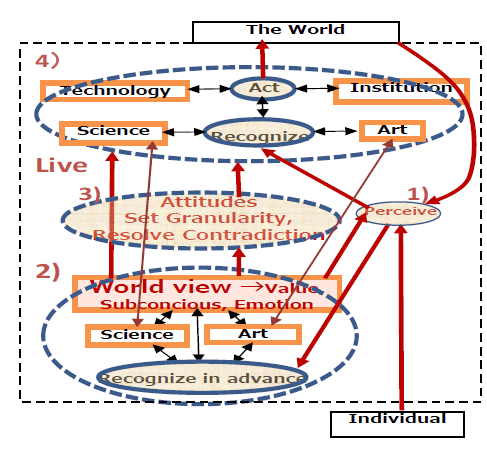
Fig. 4-1 Structure of life
1) Perception of the World by individual. Even perception is complicated. The World, I and my sense of value, my emotion and subconscious effect my perception. My perception decide my recognition and subconscious.
2) World view is common notion on facts and values of the past, the present and the future. [THPJ201503]
It effects my sense of value, subconscious and emotion.
3) To live is an attitudes to set granularity and recognize and act using dialectic logic by individual.
4) Common means: technology, institution [TJ200306], science and art via which my recognition or action is realized. Table is recognized as table at some granularity by a common notion. This common notion or common sense is one of institutions.
.
5. To Live 3) in Fig.4.1 [FIT2013] [FIT2015]
.
For each individual the zero-basis principle may not be useful for resolving temporary issues. The issue expressed by usual change or temporary Contradiction may be resolved. The method is in [THPJ201501, 02].
At the same time our attitudes and action should be for trying to acquire values on zero-basis. The values are a series of the continuation of species of human being, life of individuals and diversified attributes of individual. [FIT201501] Attributes and action of individual is as same as relation between me and outside object or “I–relation–Object”. To live is to decide “I–relation–Object”.
Firstly the relation is enumerated “to change thought on zero-basis and act, to change existing thought and act or not to change”. I select “to change thought on zero-basis”. Secondly I enumerate utmost ideal elements of “change on zero-basis” to be “Modesty and criticism” from a granularity of attitude and “love and liberty” from a granularity of an action. [TS2011] [FIT2013] [FIT201501, 03] The utmost ideal elements are integrated as “sense of unity and sense of object” to become two terms of an important CU [FIT2013].
“A sense of unity” is a will to integrate me and object including other life to re-unite. The value in this sense is “love” which enhance me and object including other life as an attitude of action.
“A sense of object” is my will to operate object as an object. The value of this is “liberty” which enhance my ability to change object. [FIT2013]
The attitudes and action should extend to set granularity and to resolve CU.
This is achieved by zero-basis Principle, RET and CU.
.
6. Technology, Institution [TS2011] 4) in Fig.4.1 and World View 2) in Fig.4.1
.
To recognize and act at this moment according to value, emotion and attitudes decided by the world view is realized via common means. Means are enumerated as technology, institution, science and art. [OUYOU1990]
Technology, institution even science and art are means in which make energy work most efficiently. Generally technology and science are means for a sense of object. Institution and art are that of a sense of unity. [OUYOU1990] In the long history, institution works under the condition developed by technology. Moreover technology of energy play the important key role in human history.
We had Agricultural Revolution 8000 years ago and Industrial Revolution 200 years ago. Both of them are based on energy revolution or rather energy revolutions themselves. [IEICE2016]
The first Agricultural Revolution noticed and made use of solar energy. The second Industrial Revolution noticed and made use of fossil fuel [IEICE2016].
The age began with Agricultural Revolution which have a sense of object went on with a birth of world view of a sense of unity to nature and “God” but not necessarily fully realizing it. This is because the sense of unity is one-sided and individual was not established.
The age began with Industrial Revolution or Capitalism went on with the world view of a sense of object which change object efficiently under the condition that “modesty” and “love” in a sense of unity are insufficient. [IEICE2016] Capitalism is temporary in the meaning of both energy and institution
We get the conclusions conforming to RET, CU and energy criterion.
.
7. Today and Future
It is the third revolution to develop new energy and institutional revolution to build post-Capitalism suitable for the energy development simultaneously that we are confronted with.
We should make effort for local energy which is safe and available even at a latent environmental crisis and in every space toward universe.
Post-Capitalism will be realized with the world view unifying “a sense of unity not one-sided and a sense of object”, “modesty and criticism” or “love and liberty”, each term of which are basically the insufficient elements of the world view of the first and second revolution respectively.
Principle of “equal-values-exchange” born in development of Agricultural Revolution [IEICE2016] and a sense of belonging especially to nation and a sense of possession of today should be reconsidered toward an ideal sense of equal unity to object. This ideal sense is expressed in “Economic & Philosophical Manuscripts” by K. Marx in 1844. It is a pity that he did not extend the thought since this article.
These are the image of a future conforming to zero-basis Principle, RET, CU and energy criterion.
.
8. Two Conclusive Thoughts
.
1. The first conclusion is on form of the thinking.
The picture should be, if it should exist, like these.
I think this is an expression of “engineering thinking”.
In reality almost every people of today is not conscious on granularity. Almost all logics in thought or arguments of every people are invalid [FIT2013]. So we need RET.
We should continue to enhance value. So we need CU.
In this paper I show that we can select a candidate according to a criterion of simplicity from among the possible many World.
This simplicity is achieved by the solution of CC of the division into layers and layer which conform to the same principles and energy criterion. RET and Contradiction are dialectic logic. RET; Radical Enumerative Thinking. CU; Contradiction of Unity. CC; Compatible Contradiction.
RTE and CU also make it possible to simulate the future World in which a new value should be realized.
To rebuild thoughts on everything by the minimum basic concepts on the zero-basis make it easier to implement the simulation program to a computer.
But UC is not usual deduction and “RET and CU” is not usual induction nor abduction. [THPJ201503]
.
2. The second conclusion is on the contents.
This is a story of the way to our future. Situation urged me to draw the quite rough blueprint of the third revolution as hypotheses by the people and for the people.
We ought to start this revolution within a few decades.
Only this way should enrich “a sense of unity and a sense of object”, “modesty and criticism”, “love and liberty”. It would establish “individual” having a sense of unity and sense of object, thinking of individual, argument and democracy.
This might also continue to discover new truth and new value, enhance value and not necessarily make usual “growth”. This ideal relation might become the moving power of work instead of profit that has been a moving power of Capitalism since its beginning. This would make a new economy. Also it might abolish war. This might resolve every issues radically.
I think how long it will take to realize a concrete figures depends on how many people make efforts.
.
3. How to deal with other life except human being, how to realize “a sense of unity and a sense of object”, how to integrate deduction, induction and abduction, how to verify the hypotheses and how to achieve the conclusion logically are issues to be investigated.
.
Acknowledgement
I am deeply grateful to Professor Nakagawa Toru Ph. D. Emeritus of Osaka Gakuin University for giving me a lot of encouragements and useful supports for over 10 years. I am also grateful to Ellen Domb Ph. D. and Shahid S. A. Arshad Ph. D. for their helpful comments.
.
References
[THPJ] NAKAGAWA Toru, TRIZ Home Page in Japan, http://www.osaka-gu.ac.jp/php/nakagawa/TRIZ/eTRIZ/
[NAKAGAWA2016] NAKAGAWA, “Liberty vs. Love: The Principal Contradiction Inherent in the Human Culture”, http://www.osaka-gu.ac.jp/php/nakagawa/TRIZ/eTRIZ/epapers/e2016Papers/eNaka-Liberty-Love-2016/e-Naka-Liberty-Love-7u160427.html
Link to Takahara’s papers in 2003 – 2015 are in the following NAKAGAWA’s home page.
http://www.osaka-gu.ac.jp/php/nakagawa/TRIZ/eTRIZ/epapers/e2015Papers/eTakahara-Biblio3-2013-2015/eTakahara-Biblio3-151109.html
Shorten name means as follows.
[TJyyyy].: The TRIZ Journal, : year in AD
[FITyyyy].: Forum on Information Technology, : year in AD
[TSyyyy]: TRIZ Symposium in Japan,
[THPJyyyy]: TRIZ Home Page in Japan: year in AD,
[IEICEyyyy]: Institute of Electronics, Information and Communication Engineer in: year in AD,
[TS2011] TAKAHARA, “A Preparatory Study for Resolution of Contradiction of Unity―For the Way of Life―”, TS, 2011.
[TS2012] TAKAHARA, “Radical Thinking for Enumeration and Contradiction”, TS, 2012.
[FIT2013] TAKAHARA, “A Note on a Method and Granularity in the Structure of the World”, FIT, 2013. In Japanese.
[FIT2015] TAKAHARA, “The Structure of Dialectic Logic and ‘Six-Box Scheme’ by Nakagawa”, FIT, 2015. In Japanese.
[IEICE2016] TAKAHARA, “The Dialectic Logic on the Earth”, IEICE, 2016. In Japanese.
[OUYOU1990] TAKAHARA, RYU, “A Study on Ideal Technology and Information Network Systems”, J. of Appl. Science, Vol.4 No.1, pp.19 ~25, 1990. In Japanese.
[TKHR] http://www.geocities.jp/takahara_t_ieice/ In Japanese.

